Bird R.B., Stewart W.E., Lightfoot E.N. Transport Phenomena
Подождите немного. Документ загружается.


523.6
Use of the Macroscopic Balances to Solve Unsteady-State Problems
757
We begin by integrating Eq. 23.6-33, for
n
=
0, over the entire volume of the flow system
between planes
1
and 2:
The volume integrals may be converted into surface integrals by using the Gauss divergence
theorem to get
where S
=
Sf
+
S,
+
SZ. The integral over the fixed surface Sf is zero according to Eq. 23.6-27
and 28, and the integrals over the inlet and outlet planes
S,
and
S2
can be simplified, so that
we get
Here we have made use of Eq. 23.6-29 to drop the diffusive terms at planes
1
and
2.
If we as-
sume that
to'
is constant over a cross section, we may remove it from the integral, and then
we get
For an incompressible fluid, the volume rate of flow,
Q,
is constant, so that (u,)S,
=
(v&, and
That is,
I"'
evaluated at plane
1
is the same as
Po'
at plane 2, and at every point in the system.
It is standard notation to abbreviate this quantity as Mo, the zeroth (absolute) moment. Equa-
tion 23.6-38 is analogous to Eq. 23.1-2 for a steady-state system with no mass transport across
the walls. Next we evaluate
4"
for the introduction of a mass
m
of tracer over a time interval
that is very small with respect to the mean tracer residence time
t,,,
=
V/Q:
The replacement, in the second step, of the upper limit by Q/V is permitted by the finite du-
ration of the tracer pulse. From the last two equations we then get
This provides the possibility of measuring blood flow rate from the mass of an injected tracer
and the value of
Go'
=
M,.
The latter can be obtained
by
means of a catheter inserted into the
blood vessel or by NMR techniques.
This simple formula6 was first introduced in 1829 and has been extensively used since
1897 for measurement of blood-flow rates,7 including cardiac output.' It is also widely used for
many environmental systems, such as rivers, and also for systems in the process industries.
Next we turn to Eq. 23.6-32, and integrate it over the volume of the flow system, once
again making use of the fact that the diffusive tern over the inlet and outlet is much smaller
than the convective term. This gives
E.
Hering,
Zeits,
f.
Physik,
3,85-126 (1829).
G.
N.
Stewart,
J.
Physiol.
(London), 22,159-183 (1897).
K.
Zierler,
Ann.
Biomed.
Eng.,
28,836-848 (2000).
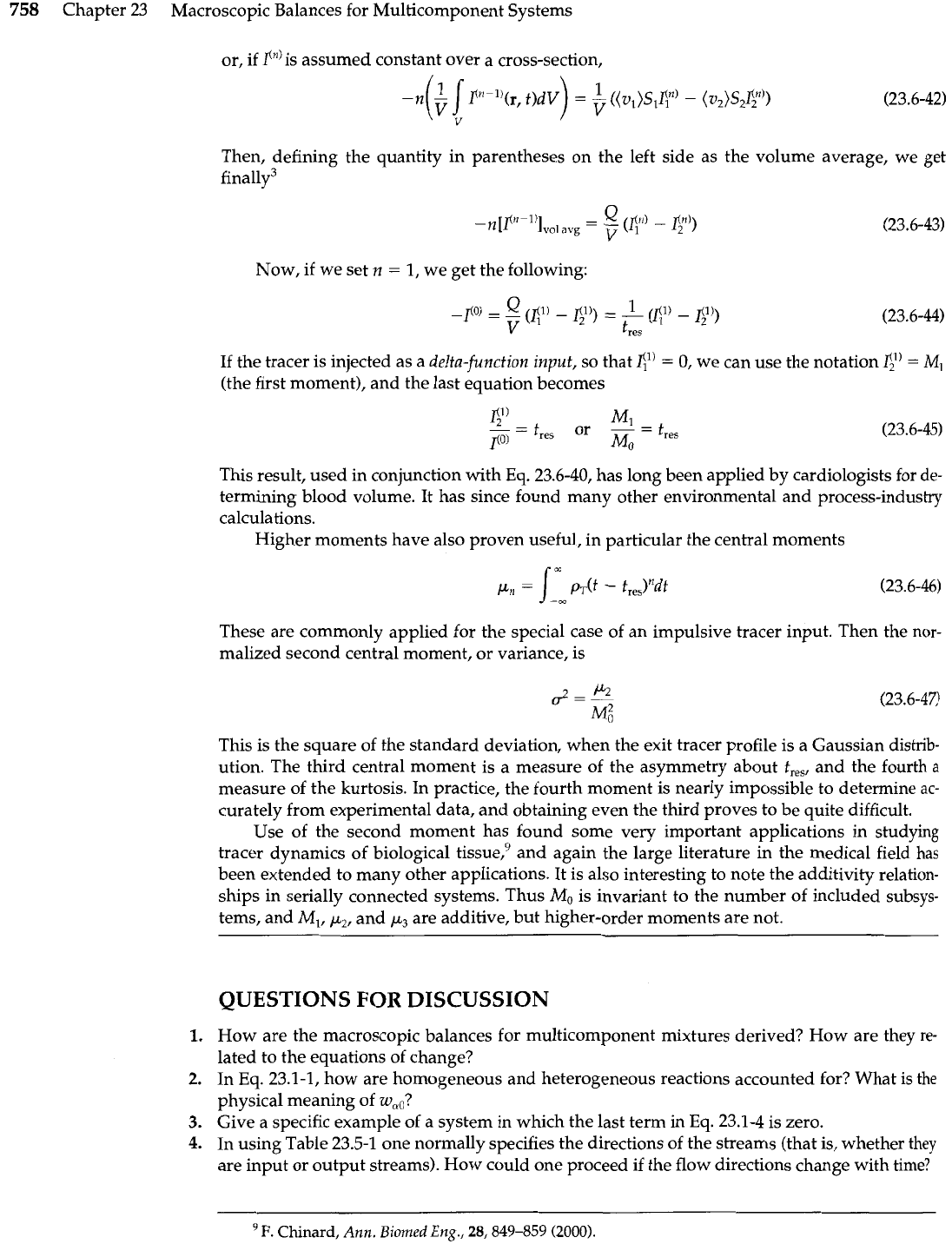
758
Chapter 23 Macroscopic Balances for Multicomponent Systems
or, if
I'"'
is assumed constant over a cross-section,
-n(+
I
~')(r,
t)~)
=
+
((v~)s~$)
-
(v~)s~@))
(23.6-42)
v
Then, defining the quantity in parentheses on the left side as the volume average, we get
finally3
Now, if we set
n
=
1, we get the following:
If the tracer is injected as a
delta-function input,
so that
I',"
=
0,
we can use the notation
I':'
=
MI
(the first moment), and the last equation becomes
This result, used in conjunction with Eq. 23.6-40, has long been applied by cardiologists for
de-
termining blood volume. It has since found many other environmental and process-industry
calculations.
Higher moments have also proven useful, in particular the central moments
These are commonly applied for the special case of an impulsive tracer input. Then the nor-
malized second central moment, or variance, is
This is the square of the standard deviation, when the exit tracer profile is a Gaussian distrib-
ution. The third central moment is a measure of the asymmetry about ire,, and the fourth
a
measure of the kurtosis. In practice, the fourth moment is nearly impossible to determine
ac-
curately from experimental data, and obtaining even the third proves to be quite difficult.
Use of the second moment has found some very important applications in studying
tracer dynamics of biological tissue? and again the large literature in the medical field
has
been extended to many other applications. It is also interesting to note the additivity relation-
ships in serially connected systems. Thus
Mo
is invariant to the number of included subsys-
tems, and
M,,
p2,
and
p3
are additive, but higher-order moments are not.
QUESTIONS
FOR
DISCUSSION
1.
How are the macroscopic balances for multicomponent mixtures derived? How are they
re-
lated to the equations of change?
2.
In Eq. 23.1-1, how are homogeneous and heterogeneous reactions accounted for? What is the
physical meaning of
w,,?
3.
Give a specific example of a system in which the last term in Eq. 23.1-4 is zero.
4.
In using Table
23.5-1
one normally specifies the directions of the streams (that is, whether they
are input or output streams). How could one proceed if the flow directions change with time?
F.
Chinard,
Ann.
Biomed
Eng.,
28,849-859
(2000).
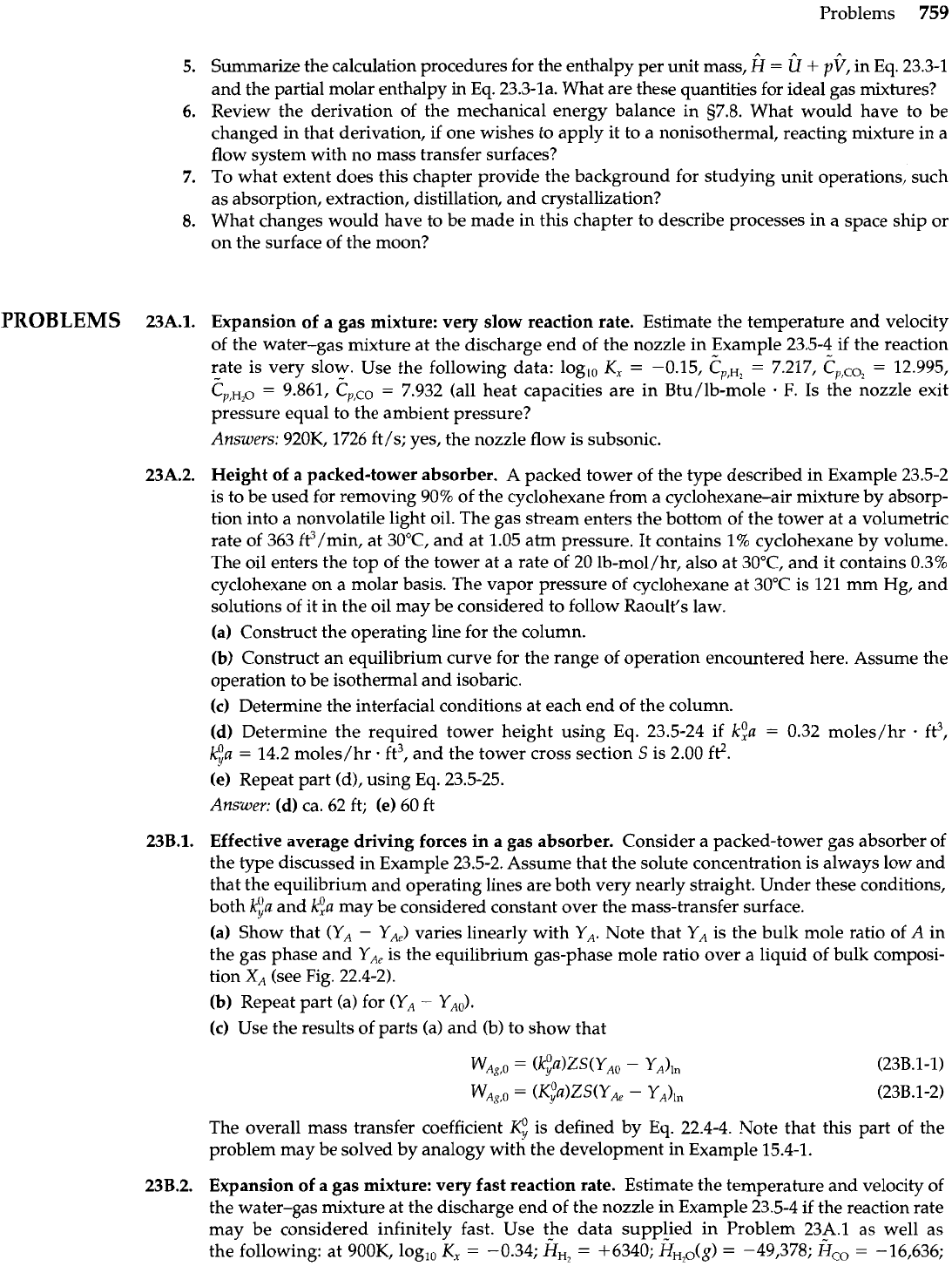
Problems
759
5.
Summarize the calculation procedures for the enthalpy per unit mass,
fi
=
+
in Eq. 23.3-1
and the partial molar enthalpy in Eq. 23.3-la. What are these quantities for ideal gas mixtures?
6.
Review the derivation of the mechanical energy balance in s7.8. What would have to be
changed in that derivation, if one wishes to apply it to a nonisothermal, reacting mixture in a
flow system with no mass transfer surfaces?
7.
To what extent does this chapter provide the background for studying unit operations, such
as absorption, extraction, distillation, and crystallization?
8.
What changes would have to be made in this chapter to describe processes in a space ship or
on the surface of the moon?
PROBLEMS
23A.1. Expansion of a gas mixture: very slow reaction rate.
Estimate the temperature and velocity
of the water-gas mixture at the discharge end of the nozzle in Example
-
23.5-4
-
if the reaction
rate
-
is very slow.
-
Use the following data: loglo
K,
=
-0.15, CprHz
=
7.217, Cp,CO,
=
12.995,
Cp,HZO
=
9.861, Cp,,,
=
7.932 (all heat capacities are in Btu/lb-mole
-
F.
Is the nozzle exit
pressure equal to the ambient pressure?
Answers:
920K, 1726 ft/s; yes, the nozzle flow is subsonic.
23A.2. Height of a packed-tower absorber.
A
packed tower of the type described in Example 23.5-2
is to be used for removing 90% of the cyclohexane from a cyclohexane-air mixture by absorp-
tion into a nonvolatile light oil. The gas stream enters the bottom of the tower at a volumetric
rate of 363 ft3/min, at 30°C, and at 1.05 atm pressure. It contains 1% cyclohexane by volume.
The oil enters the top of the tower at a rate of 20 lb-mol/hr, also at 30°C, and it contains 0.3%
cyclohexane on a molar basis. The vapor pressure of cyclohexane at
30°C
is 121 mm Hg, and
solutions of it in the oil may be considered to follow Raoult's law.
(a)
Construct the operating line for the column.
(b)
Construct an equilibrium curve for the range of operation encountered here. Assume the
operation to be isothermal and isobaric.
(c)
Determine the interfacial conditions at each end of the column.
(d)
Determine the required tower height using Eq. 23.5-24 if
k!a
=
0.32 moles/hr
.
ft3,
kia
=
14.2 moles/hr
.
ft3, and the tower cross section
S
is 2.00
fi?.
(e)
Repeat part (d), using Eq. 23.5-25.
Answer:
(d)
ca. 62 ft;
(el
60 ft
23B.1. Effective average driving forces in a gas absorber.
Consider a packed-tower gas absorber of
the type discussed in Example 23.5-2. Assume that the solute concentration is always low and
that the equilibrium and operating lines are both very nearly straight. Under these conditions,
both
k;a
and
k:a
may be considered constant over the mass-transfer surface.
(a)
Show that
(YA
-
Y,,)
varies linearly with
YA.
Note that Y, is the bulk mole ratio of
A
in
the gas phase and
Y,,
is the equilibrium gas-phase mole ratio over a liquid of bulk composi-
tion
X,
(see Fig. 22.4-2).
(b)
Repeat part (a) for
(Y,
-
YAO).
(c)
Use the results of parts (a) and (b) to show that
The overall mass transfer coefficient
I$
is defined by Eq. 22.4-4. Note that this part of the
problem may be solved by analogy with the development in Example 15.4-1.
23B.2. Expansion of a gas mixture: very fast reaction rate.
Estimate the temperature and velocity of
the water-gas mixture at the discharge end of the nozzle in Example 23.5-4 if the reaction rate
may be considered infinitely fast. Use the data supplied in Problem 23A.1 as well as
the following: at 900K, loglo
K,
=
-0.34;
3H2
=
+6340; HHz0(@
=
-49,378;
&,
=
-16,636;
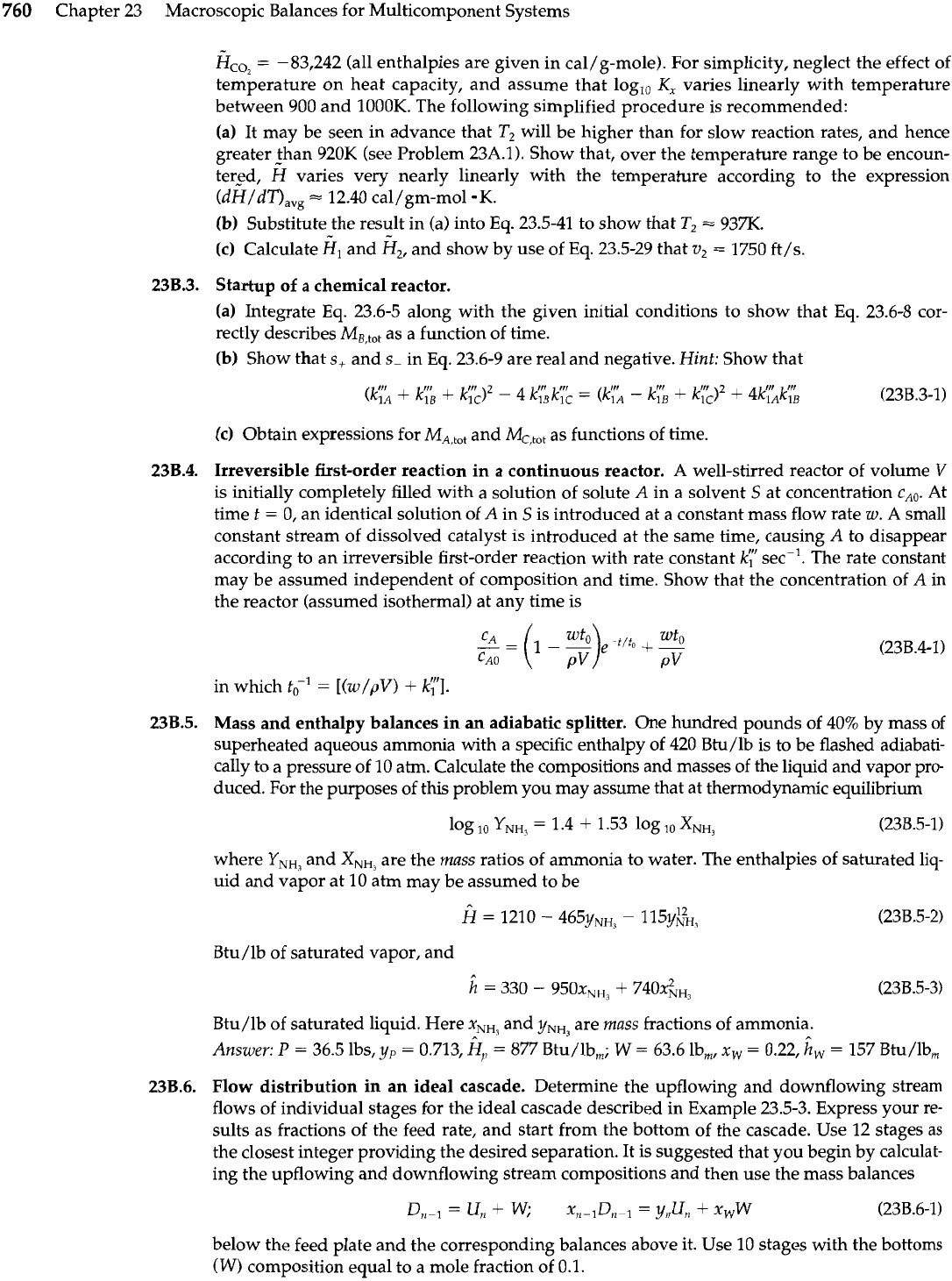
760
Chapter 23 Macroscopic Balances for Multicomponent Systems
ho,
=
-83,242 (all enthalpies are given in cal/g-mole). For simplicity, neglect the effect of
temperature on heat capacity, and assume that loglo
K,
varies linearly with temperature
between 900 and 1000K. The following simplified procedure is recommended:
(a) It may be seen in advance that
T2
will be higher than for slow reaction rates, and hence
greater than 920K (see Problem 23A.1). Show that, over the temperature range to be encoun-
tersd,
fi
varies very nearly linearly with the temperature according to the expression
(dH/dT',,,
=
12.40 cal/gm-mol
K.
(b)
Substitute the result in
(a)
into Eq. 23.5-41 to show that
T,
=
937K.
(c)
Calculate
HI
and
&
and show by use of Eq. 23.5-29 that
v,
=
1750 ft/s.
Startup of a chemical reactor.
(a) Integrate Eq. 23.6-5 along with the given initial conditions to show that Eq. 23.6-8 cor-
rectly describes
MB,tot
as a function of time.
(b) Show that
s+
and
s-
in Eq. 23.6-9 are real and negative.
Hint:
Show that
(c)
Obtain expressions for
MA,t,,
and
Mc,tot
as functions of time.
Irreversible first-order reaction in a continuous reactor.
A
well-stirred reactor of volume
V
is initially completely filled with a solution of solute
A
in a solvent
S
at concentration
cAo.
At
time
t
=
0, an identical solution of
A
in
S
is introduced at a constant mass flow rate w. A small
constant stream of dissolved catalyst is introduced at the same time, causing
A
to disappear
according to an irreversible first-order reaction with rate constant
ky
sec-'. The rate constant
may be assumed independent of composition and time. Show that the concentration of
A
in
the reactor (assumed isothermal) at any time is
in which
t;'
=
[(w/pV)
+
ky].
Mass and enthalpy balances in
an
adiabatic splitter. One hundred pounds of 40% by mass of
superheated aqueous ammonia with a specific enthalpy of 420 Btu/lb is to be flashed adiabati-
cally to a pressure of 10 atm. Calculate the compositions and masses of the liquid and vapor pro-
duced. For the purposes of this problem you may assume that at thermodynamic equilibrium
where
YNHi
and
XNH3
are the
mass
ratios of ammonia to water. The enthalpies of saturated liq-
uid and vapor at 10 atm may be assumed to be
Btu/lb of saturated vapor, and
Btu/lb of saturated liquid. Here
xNH3
and
yNH,
are
mass
fractions of ammonia.
A
Answer:
P
=
36.5 Ibs,yp
=
0.713,
Hp
=
877 Btu/lb,;
W
=
63.6 Ib,,
x,
=
0.22,
h,
=
157 Btu/lb,
Flow distribution in an ideal cascade. Determine the upflowing and downflowing stream
flows of individual stages for the ideal cascade described in Example 23.5-3. Express your re-
sults as fractions of the feed rate, and start from the bottom of the cascade. Use 12 stages as
the closest integer providing the desired separation. It is suggested that you begin by calculat-
ing the upflowing and downflowing stream compositions and then use the mass balances
below the feed plate and the corresponding balances above it. Use 10 stages with the bottoms
(W) composition equal to a mole fraction of 0.1.
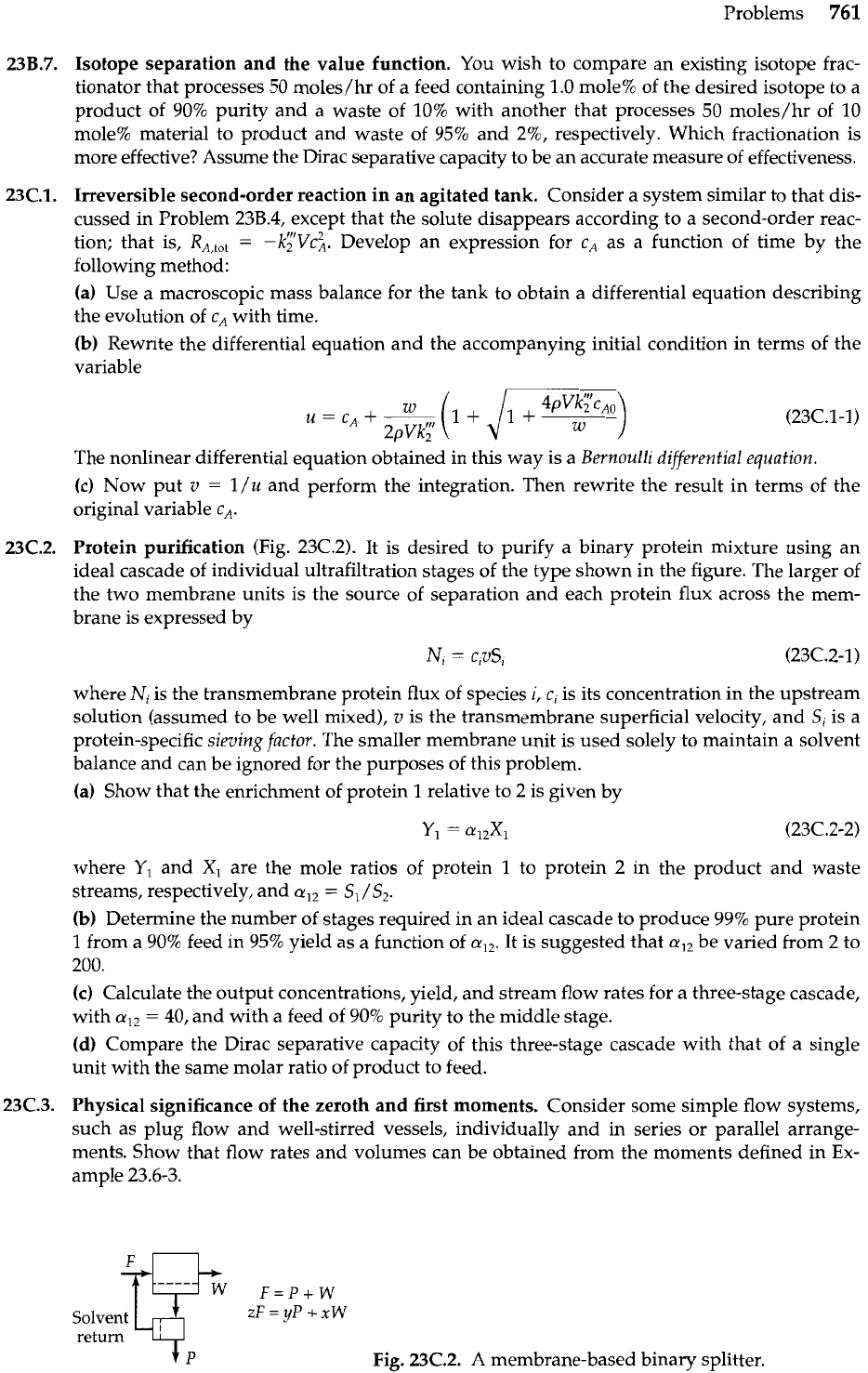
Problems
761
23B.7.
Isotope separation and the value function. You wish to compare an existing isotope frac-
tionator that processes 50 moles/hr of a feed containing 1.0 mole% of the desired isotope to a
product of 90% purity and a waste of 10% with another that processes 50 moles/hr of
10
mole% material to product and waste of 95% and 2%, respectively. Which fractionation is
more effective? Assume the Dirac separative capacity to be an accurate measure of effectiveness.
Irreversible second-order reaction in an agitated tank. Consider a system similar to that dis-
cussed in Problem 23B.4, except that the solute disappears according to a second-order reac-
tion; that is,
RA,t,,
=
-k;'Vci.
Develop an expression for
c,
as
a
function of time by the
following method:
(a) Use a macroscopic mass balance for the tank to obtain a differential equation describing
the evolution of
cA
with time.
(b) Rewrite the differential equation and the accompanying initial condition in terms of the
variable
The nonlinear differential equation obtained in this way is a
Bernoulli difj'erential equation.
(c)
Now put
v
=
l/u and perform the integration. Then rewrite the result in terms of the
original variable
c,.
23C.2.
Protein purification (Fig. 23C.2). It is desired to purify a binary protein mixture using an
ideal cascade of individual ultrafiltration stages of the type shown in the figure. The larger of
the two membrane units is the source of separation and each protein flux across the mem-
brane is expressed by
where
Ni
is the transmembrane protein flux of species
i,
ci
is its concentration in the upstream
solution (assumed to be well mixed),
v
is the transmembrane superficial velocity, and
Si
is a
protein-specific
sieving factor.
The smaller membrane unit is used solely to maintain a solvent
balance and can be ignored for the purposes of this problem.
(a) Show that the enrichment of protein 1 relative to
2
is given by
where
Y,
and
XI
are the mole ratios of protein 1 to protein
2
in the product and waste
streams, respectively, and
a,,
=
S,/S2.
(b)
Determine the number of stages required in an ideal cascade to produce 99% pure protein
1 from a 90% feed in 95% yield as a function of
a,,.
It is suggested that
a,,
be varied from
2
to
200.
(c)
Calculate the output concentrations, yield, and stream flow rates for a three-stage cascade,
with
a,,
=
40, and with a feed of 90% purity to the middle stage.
(d)
Compare the Dirac separative capacity of this three-stage cascade with that of a single
unit with the same molar ratio of product to feed.
23C.3.
Physical significance of the zeroth and first moments. Consider some simple flow systems,
such as plug flow and well-stirred vessels, individually and in series or parallel arrange-
ments. Show that flow rates and volumes can be obtained from the moments defined in
Ex-
ample 23.6-3.
F=P+W
zF=yP+xW
return
Fig.
23C.2.
A
membrane-based binary splitter.
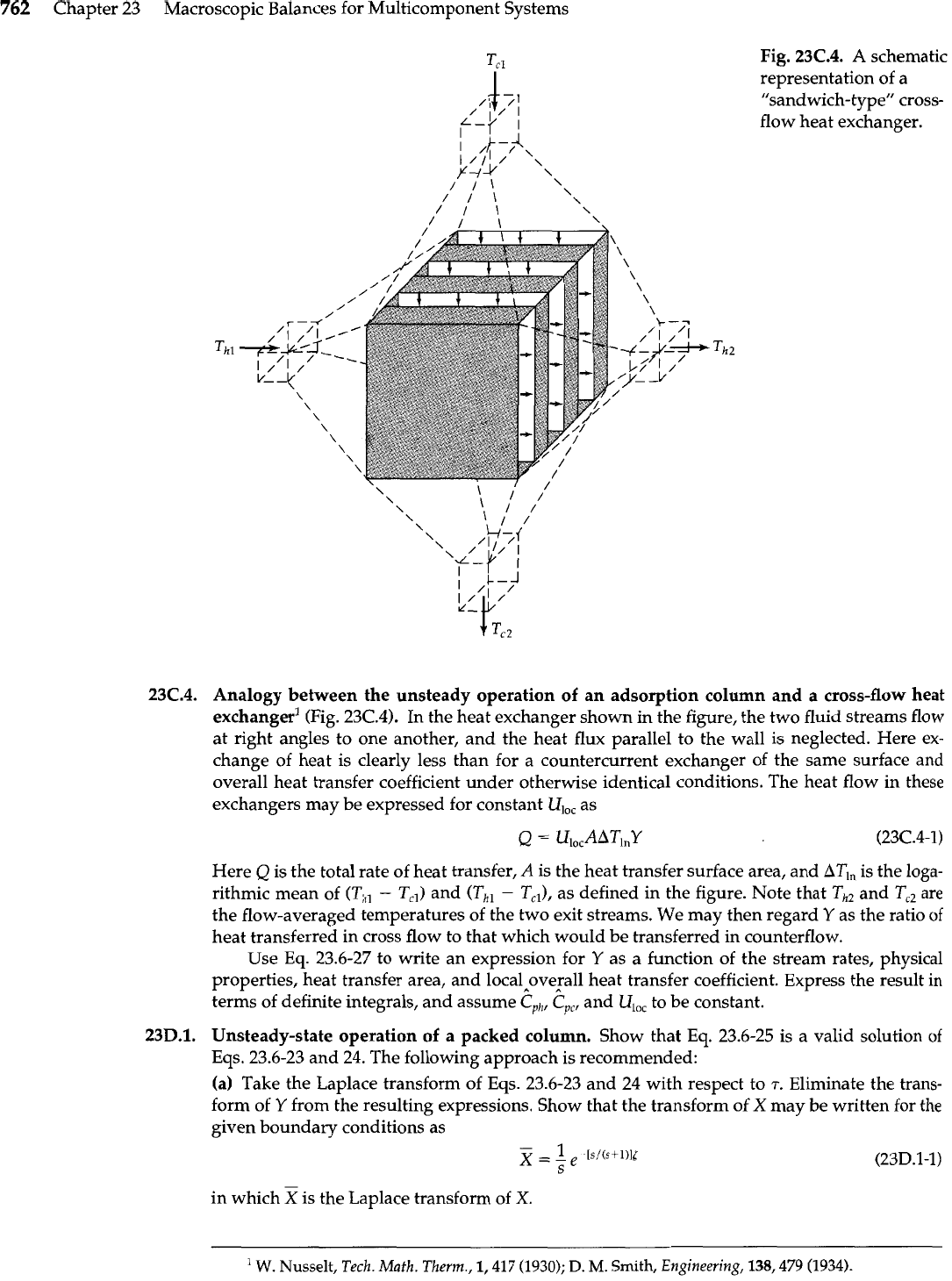
762
Chapter 23 Macroscopic Balances for Multicomponent Systems
Fig.
23C.4.
A
schematic
representation of a
"sandwich-type'' cross-
flow heat exchanger.
23C.4.
Analogy between the unsteady operation of an adsorption column and a cross-flow heat
exchanger1 (Fig. 23C.4). In the heat exchanger shown in the figure, the two fluid streams flow
at right angles to one another, and the heat flux parallel to the wall is neglected. Here ex-
change of heat is clearly less than for a countercurrent exchanger of the same surface and
overall heat transfer coefficient under otherwise identical conditions. The heat flow in these
exchangers may be expressed for constant Ul,, as
Here
Q
is the total rate of heat transfer,
A
is the heat transfer surface area, and ATl, is the loga-
rithmic mean of (T,ll
-
T,,) and (T,,
-
Tcl), as defined in the figure. Note that Th2 and
T,,
are
the flow-averaged temperatures of the two exit streams. We may then regard
Y
as the ratio
of
heat transferred in cross flow to that which would be transferred in counterflow.
Use Eq. 23.6-27 to write an expression for
Y
as a function of the stream rates, physical
properties, heat transfer area, and localpve~all heat transfer coefficient. Express the result in
terms of definite integrals, and assume Cphr Cpcr and
U,,,
to be constant.
23D.1.
Unsteady-state operation of a packed column. Show that Eq. 23.6-25 is a valid solution
of
Eqs. 23.6-23 and 24. The following approach is recommended:
(a) Take the Laplace transform of Eqs. 23.6-23 and 24 with respect to
r.
Eliminate the trans-
form of
Y
from the resulting expressions. Show that the transform of
X
may be written for the
given boundary conditions as
-
X
=
l
,
[s/(s+l)lt
s
(23D.1-1)
in which
k
is the Laplace transform of
X.
W.
Nusselt,
Tech. Math. Therm.,
1,417 (1930);
D.
M.
Smith,
Engineering,
138,479 (1934).
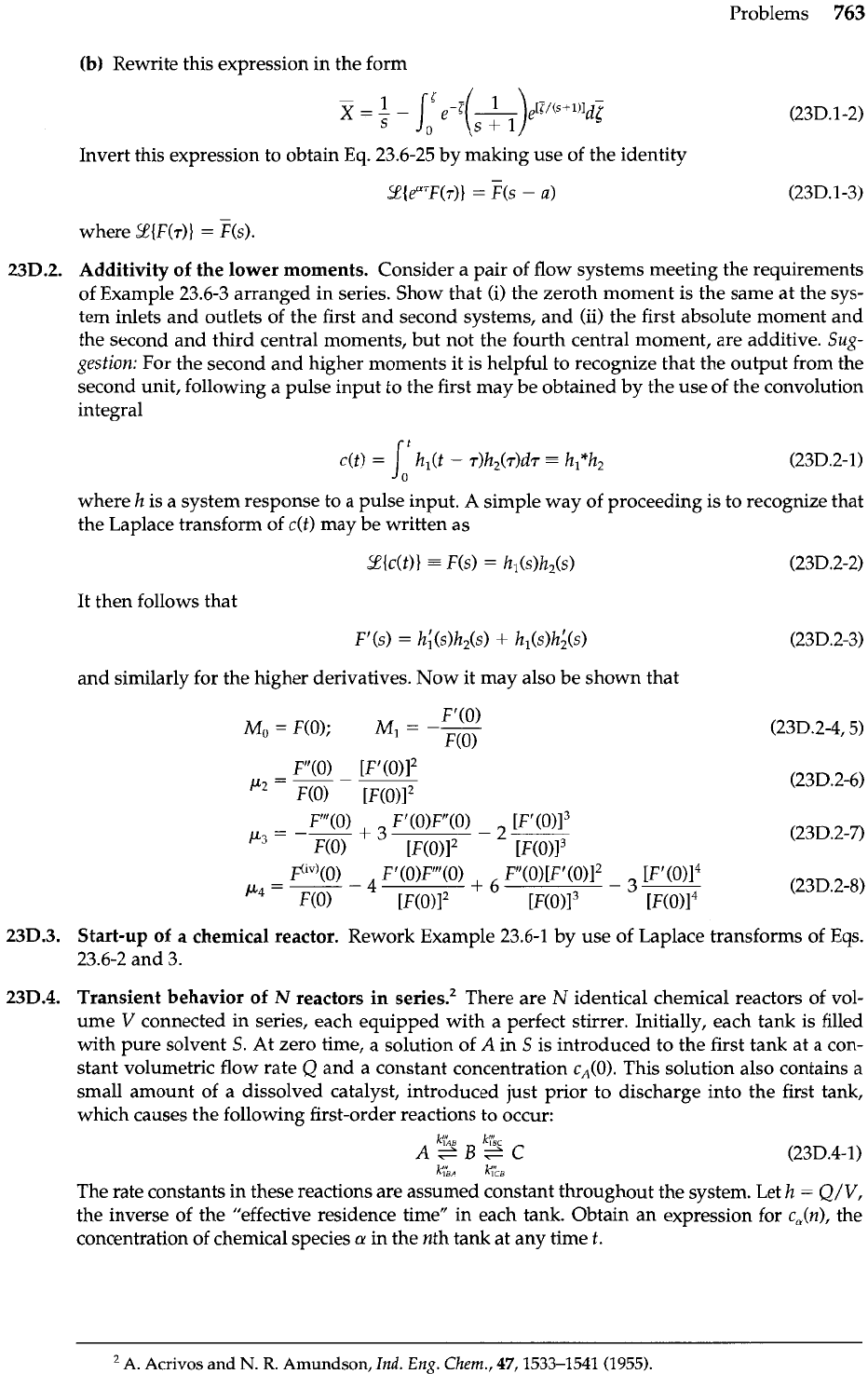
Problems
763
(b) Rewrite this expression in the form
Invert this expression to obtain Eq. 23.6-25 by making use of the identity
23D.2.
Additivity of the lower moments. Consider a pair of flow systems meeting the requirements
of Example 23.6-3 arranged in series. Show that (i) the zeroth moment is the same at the sys-
tem inlets and outlets of the first and second systems, and (ii) the first absolute moment and
the second and third central moments, but not the fourth central moment, are additive.
Sug-
gestion:
For the second and higher moments it is helpful to recognize that the output from the
second unit, following a pulse input to the first may be obtained by the use of the convolution
integral
where
k
is a system response to a pulse input. A simple way of proceeding is to recognize that
the Laplace transform of
c(t)
may be written as
It then follows that
and similarly for the higher derivatives. Now it may also be shown that
23D.3.
Start-up of a chemical reactor. Rework Example 23.6-1 by use of Laplace transforms of Eqs.
23.6-2 and 3.
23D.4.
Transient behavior of
N
reactors in ~eries.~ There are
N
identical chemical reactors of vol-
ume
V
connected in series, each equipped with a perfect stirrer. Initially, each tank is filled
with pure solvent
S.
At zero time, a solution of
A
in
S
is introduced to the first tank at
a
con-
stant volumetric flow rate
Q
and a constant concentration c,(O). This solution also contains a
small amount of a dissolved catalyst, introduced just prior to discharge into the first tank,
which causes the following first-order reactions to occur:
k;Ls
kYhc
ASBSC
(23D.4-1)
A
ki'b
The rate constants in these reactions are assumed constant throughout the system. Let
h
=
Q/V,
the inverse of the "effective residence time" in each tank. Obtain an expression for
c,(n),
the
concentration of chemical species
n
in the nth tank at any time
t.
A.
Acrivos
and
N.
R.
Amundson,
Ind.
Eng.
Chem., 47,1533-1541 (1955).
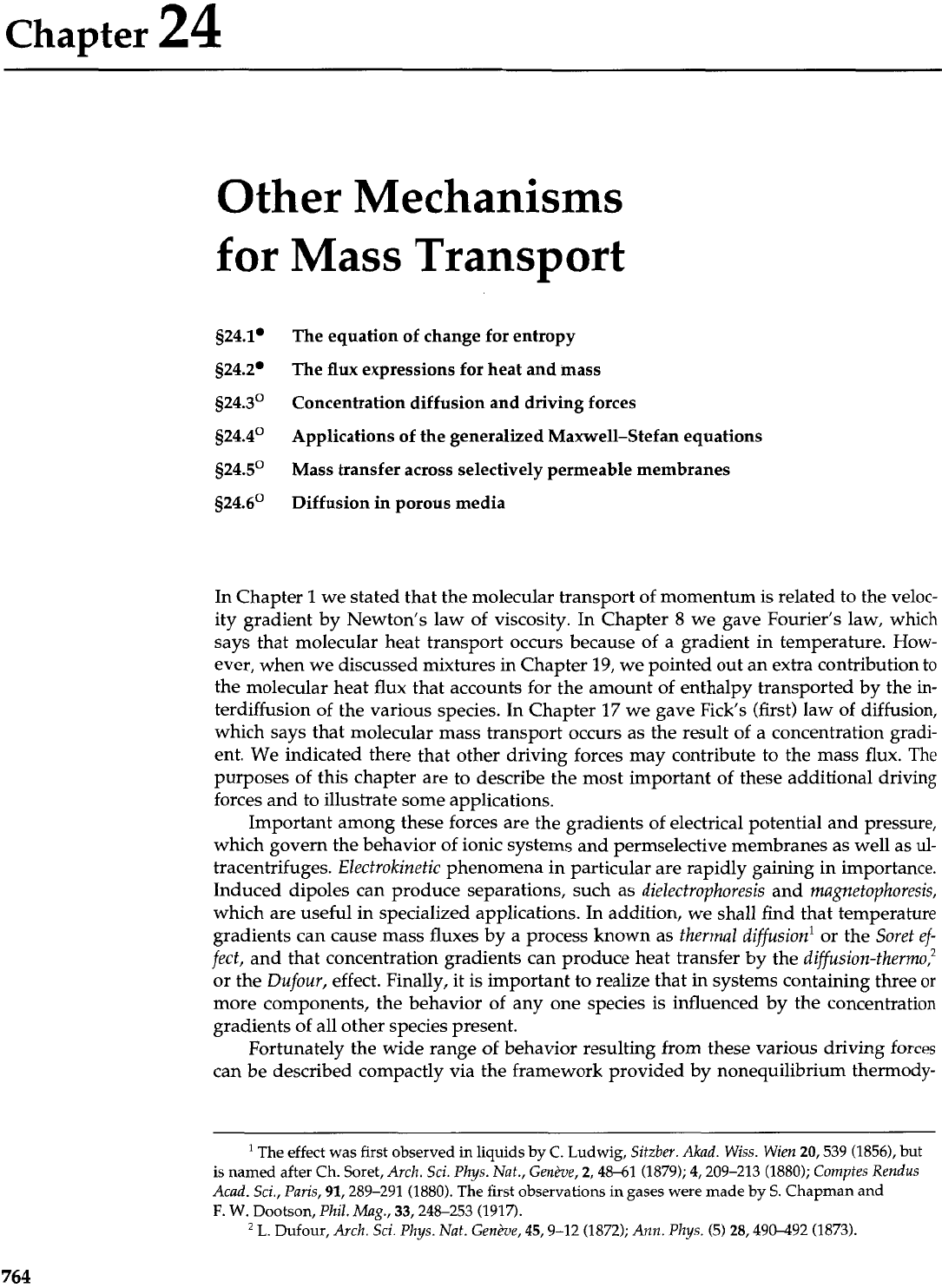
Chapter
24
Other Mechanisms
for
524.1.
924.2.
524.3'
524.4'
924.5'
524.6'
Mass Transport
The equation of change for entropy
The
flux expressions for heat and mass
Concentration diffusion and driving forces
Applications of the generalized Maxwell-Stefan equations
Mass transfer across selectively permeable membranes
Diffusion in porous media
In Chapter
1
we stated that the molecular transport of momentum is related to the veloc-
ity gradient by Newton's law of viscosity. In Chapter
8
we gave Fourier's law, which
says that molecular heat transport occurs because of
a
gradient in temperature. How-
ever, when we discussed mixtures in Chapter
19,
we pointed out an extra contribution
to
the molecular heat flux that accounts for the amount of enthalpy transported by the in-
terdiffusion of the various species. In Chapter
17
we gave Fick's (first) law of diffusion,
which says that molecular mass transport occurs as the result of a concentration gradi-
ent. We indicated there that other driving forces may contribute to the mass flux. The
purposes of this chapter are to describe the most important of these additional driving
forces and to illustrate some applications.
Important among these forces are the gradients of electrical potential and pressure,
which govern the behavior of ionic systems and permselective membranes as well as
ul-
tracentrifuges. Electrokinetic phenomena in particular are rapidly gaining in importance.
Induced dipoles can produce separations, such as dielectrophoresis and magnetophoresis,
which are useful in specialized applications. In addition, we shall find that temperature
gradients can cause mass fluxes by a process known as thermal diffusion1 or the Soret ef-
fect, and that concentration gradients can produce heat transfer by the diffusion-therrn~,~
or the Dufour, effect. Finally, it is important to realize that in systems containing three or
more components, the behavior of any one species is influenced by the concentration
gradients of all other species present.
Fortunately the wide range of behavior resulting from these various driving forces
can be described compactly via the framework provided by nonequilibrium thermody-
'
The
effect was first observed
in
liquids by
C.
Ludwig,
Sitzber. Akad. Wiss. Wien
20,539 (1856),
but
is named after
Ch.
Soret,
Arch. Sci. Phys.
Nat.,
Genhe,
2,4841 (1879); 4,209-213 (1880);
Comptes Rendus
Acad. Sci., Paris,
91,289-291 (1880).
The first observations
in
gases were made by
S.
Chapman and
F. W.
Dootson,
Phil. Mag.,
33,248-253 (1917).
L.
Dufour,
Arch. Sci. Pkys. Nut. Gentve,
45,9-12 (1872);
Ann.
Phys.
(5) 28,490492 (1873).
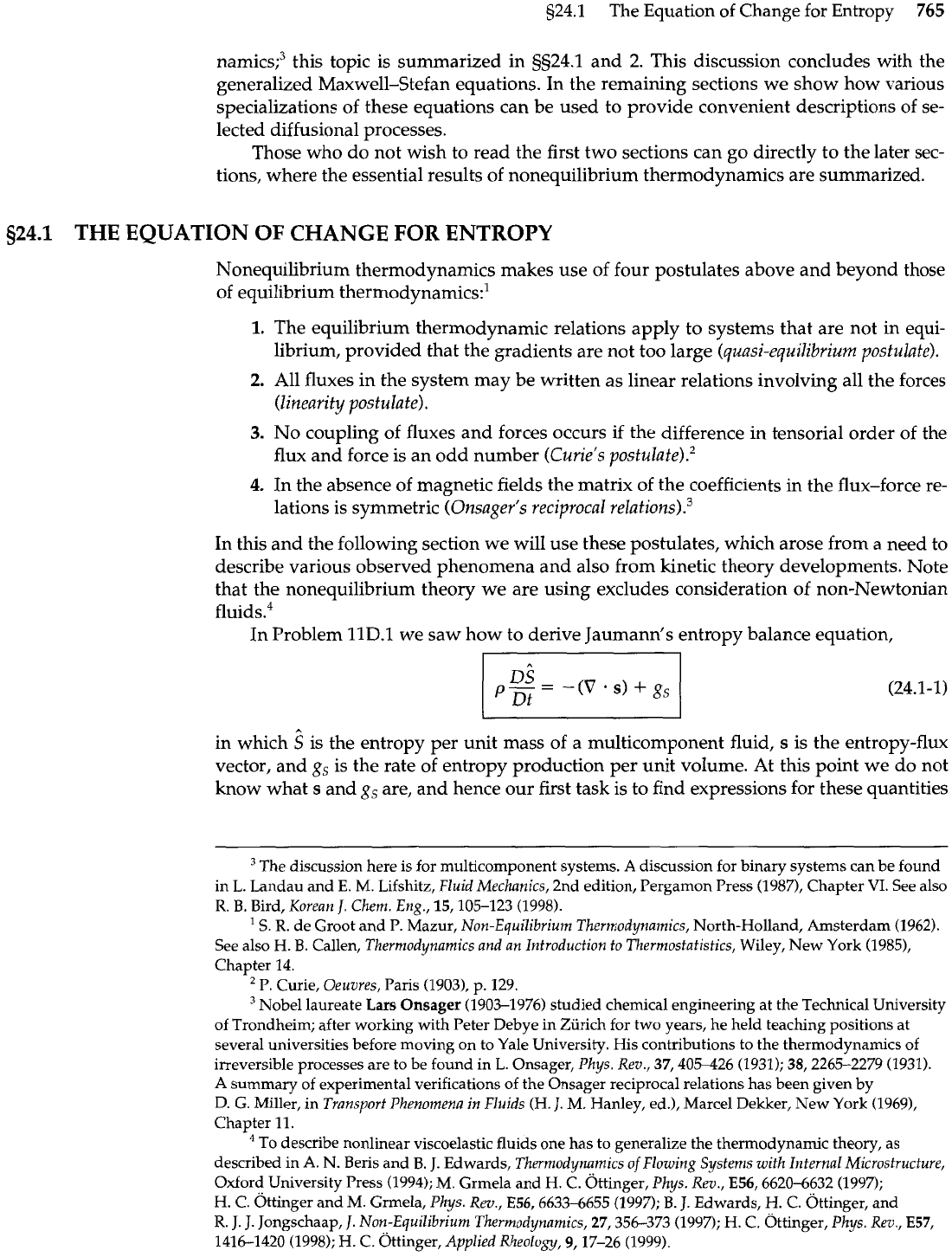
s24.1
The Equation of Change for Entropy
765
narni~s;~ this topic is summarized in
gg24.1
and
2.
This discussion concludes with the
generalized Maxwell-Stefan equations. In the remaining sections we show how various
specializations of these equations can be used to provide convenient descriptions of se-
lected diffusional processes.
Those who do not wish to read the first two sections can go directly to the later sec-
tions, where the essential results of nonequilibrium thermodynamics are summarized.
524.1
THE EQUATION
OF
CHANGE FOR ENTROPY
Nonequilibrium thermodynamics makes use of four postulates above and beyond those
of equilibrium thermodynamics:'
The equilibrium thermodynamic relations apply to systems that are not in equi-
librium, provided that the gradients are not too large (quasi-equilibrium postulate).
All fluxes in the system may be written as linear relations involving all the forces
(linearity postulate).
No coupling of fluxes and forces occurs if the difference in tensorial order of the
flux and force is an odd number (Curie's postulate).'
In the absence of magnetic fields the matrix of the coefficients in the flux-force re-
lations is symmetric (Onsager's reciprocal relationsh3
In this and the following section we will use these postulates, which arose from
a
need to
describe various observed phenomena and also from kinetic theory developments. Note
that the nonequilibrium theory we
are
using excludes consideration of non-Newtonian
fluid^.^
In Problem
11D.1
we saw how to derive Jaumann's entropy balance equation,
in which
s
is the entropy per unit mass of a multicomponent fluid,
s
is the entropy-flux
vector, and
g,
is the rate of entropy production per unit volume. At this point we do not
know what
s
and
g,
are, and hence our first task is to find expressions for these quantities
The discussion here is for multicomponent systems.
A
discussion for binary systems can be found
in L. Landau and E.
M.
Lifshitz,
Fluid Mechanics,
2nd edition, Pergamon Press (1987), Chapter
VI.
See also
R.
B. Bird,
Korean
J.
Chem. Eng.,
15,105-123 (1998).
S.
R.
de Groot and P. Mazur,
Non-Equilibrium Thermodynamics,
North-Holland, Amsterdam (1962).
See also H.
B.
Callen,
Thermodynamics and an Introduction to Thermostatistics,
Wiley, New York (1985),
Chapter 14.
'
P. Curie,
Oeuvres,
Paris (1903), p. 129.
Nobel laureate
Lars
Onsager
(1903-1976) studied chemical engineering at the Technical University
of Trondheim; after working with Peter Debye in Ziirich for two years, he held teaching positions at
several universities before moving on to Yale University. His contributions to the thermodynamics of
irreversible processes are to be found in
L.
Onsager,
Pkys. Rev.,
37,405426 (1931); 38,2265-2279 (1931).
A
summary of experimental verifications of the Onsager reciprocal relations has been given by
D.
G.
Miller, in
Transporf Phenomena
in
Fluids
(H.
J.
M. Hanley, ed.), Marcel Dekker, New York (19691,
Chapter 11.
TO describe nonlinear viscoelastic fluids one has to generalize the thermodynamic theory, as
described in A. N. Beris and
B.
J. Edwards,
Thermodymmics of Flowing Systems with Internal Microstructure,
Oxford University Press (1994); M. Grmela and H. C. Ottinger,
Pkys. Rev.,
E56,6620-6632 (1997);
H.
C. Ottinger and
M.
Grmela,
Phys.
Rev.,
E56,66334655 (1997);
B.
J.
Edwards,
H.
C. Ottinger, and
R.
J.
J. Jongschaap,
J.
Non-Equilibrium Thermodynamics,
27,356-373 (1997); H. C. Ottinger,
Pkys. Rev.,
E57,
1416-1420 (1998); H.
C.
Ottinger,
Applied Rheology,
9,17-26 (1999).
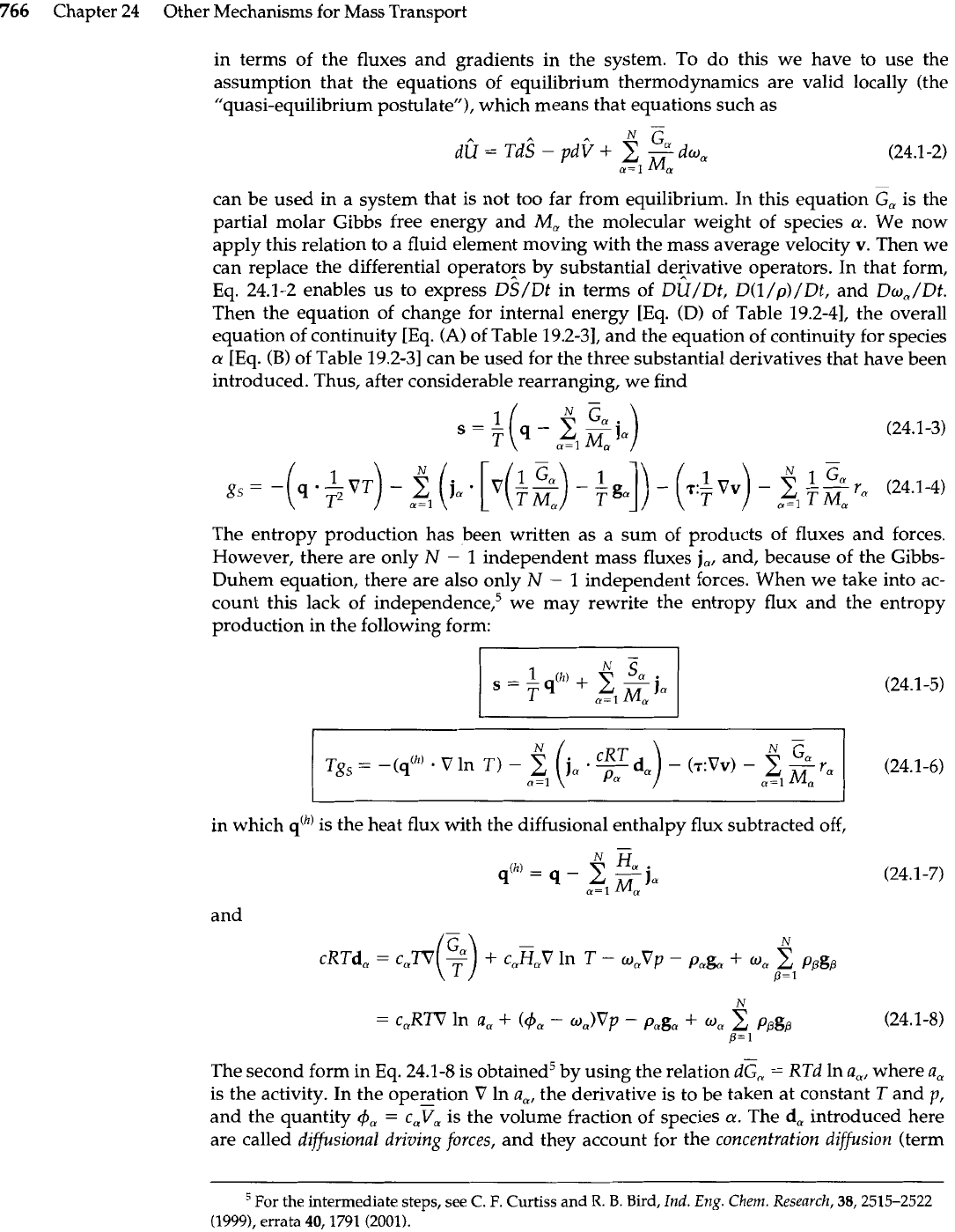
766
Chapter
24
Other Mechanisms for Mass Transport
in terms of the fluxes and gradients in the system. To do this we have to use the
assumption that the equations of equilibrium thermodynamics are valid locally (the
"quasi-equilibrium postulate"), which means that equations such as
can be used in a system that is not too far from equilibrium. In this equation
&
is the
partial molar Gibbs free energy and
M,
the molecular weight of species
a.
We now
apply this relation to a fluid element moving with the mass average velocity v. Then we
can replace the differential operators by substantial derivative operators. In that form,
Eq. 24.1-2 enables us to express
DS/D~
in terms of DU/D~, D(l/p)/DL, and Dw,/Dt.
Then the equation of change for internal energy
[Eq.
(D)
of Table 19.2-41, the overall
equation of continuity [Eq.
(A)
of Table 19.2-31, and the equation of continuity for species
a
[Eq.
(B)
of Table 19.2-31 can be used for the three substantial derivatives that have been
introduced. Thus, after considerable rearranging, we find
The entropy production has been written as a sum of products of fluxes and forces.
However, there are only
N
-
1 independent mass fluxes
j,,
and, because of the Gibbs-
Duhem equation, there are also only
N
-
1 independent forces. When we take into ac-
count this lack of independencef5 we may rewrite the entropy flux and the entropy
production in the following form:
N
~g~
=
-
(@)
.
Vln
T)-
2
j,
--
a=l
(
'::dm) -(T:vv)-
in which
q(h)
is the heat flux with the diffusional enthalpy flux subtracted off,
and
The second form in Eq. 24.1-8 is obtained5 by using the relation
d<
=
RTd In a,, where a,
is the activity. In the operation
V
In a,, the derivative is to be taken at constant
T
and
p,
and the quantity
4,
=
c,K is the volume fraction of species
a.
The d, introduced here
are called diffusional driving forces, and they account for the concentration diffusion (term
For
the
intermediate steps, see C.
F.
Curtiss and
R.
B.
Bird,
Ind.
Eng.
Chem.
Research,
38,2515-2522
(19991,
errata
40,1791 (2001).
